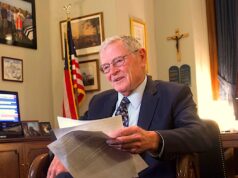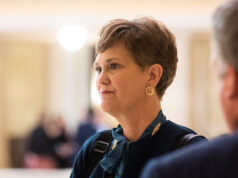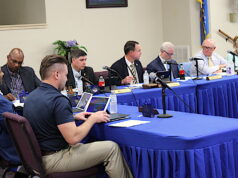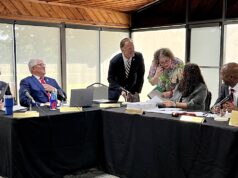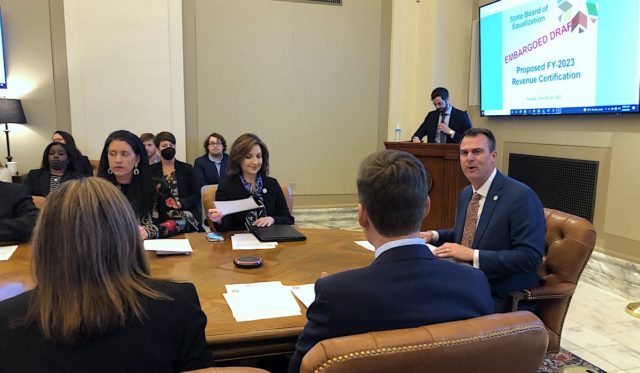

During today’s meeting of the State Board of Equalization, Gov. Kevin Stitt smiled when a budget analyst noted that Oklahoma is estimated to start next fiscal year with $2.5 billion in savings, or a 47.1 percent reserve, which ranks fourth in the country among all states. Stitt turned over his left shoulder and winked at Senate Appropriations and Budget Chairman Roger Thompson.
“I’m happy about the savings,” Thompson (R-Okemah) said after the meeting. “Whenever we stress-tested the budget, I think we need to have at least $2.3 billion in all of our savings accounts. We’re going to be there without a problem this year.”
Stitt and Thompson’s excitement stemmed from an organic deposit of an additional $230.1 million into the Revenue Stabilization Fund and other anticipated deposits of about $70 million into the state’s Constitutional Reserve Fund, otherwise called the Rainy Day Fund.
“(We have) an organic deposit in a fund that has been created since I have been in the Legislature, I think that’s a good deal,” said House Appropriations and Budget Chairman Kevin Wallace (R-Wellston). “The actual growth of the economy is only about 2 percent. A lot of good decisions have been made over the last few years that has propped the state up in a really sound financial position, so I am excited about that.”
Stitt agreed and praised Thompson and Wallace.
“Without them, we wouldn’t be in the situation that we are in,” Stitt said. “I know they are watching and looking at this reoccurring revenue and holding expenses down and investing where we need to.”
Stitt echoed the budget chairmen’s remarks about needing to be conservative with next year’s budget after the December meeting of the Board of Equalization.
“We can’t put our taxpayers in a situation where we spend more than we are taking in,” he said.
Thompson said the state’s solid savings accounts could prove valuable next session when lawmakers are building the Fiscal Year 2024 budget.
“I’m still convinced FY 24 is going to look different than FY 23, so the money that we can save this year is a good thing,” he said.
Wallace said onlookers should not anticipate “huge investments this year,” despite the ability to make some targeted agency appropriation increases.
“I wouldn’t look for an aggressive budget that would appropriate more than our growth. Our growth is about 2 percent as far the economy,” Wallace said. “The appropriations authority is much higher than the previous year, however, a lot of that is based on savings and what we have done in previous legislatures.”
Wallace said that, combined, state agencies have requested $658 million more for the Fiscal Year 2023 budget than they received in this fiscal year’s appropriations.
“There will be additional appropriations to many agencies. Exactly how much, I don’t know,” Wallace said. “That gets gathered up and brought to me by the [subcommittee] chairs, by bills that are passed out here and the whole process that is transparent, if people are paying attention to it.”
Wallace said early budget negotiations are going “fairly well.” He, Thompson, budget vice chairmen and two representatives from the Stitt administration — Secretary of State Brian Bingman and Chief Operating Officer Steven Harpe — met for about an hour and a half over lunch Tuesday in Thompson’s office.
“The only thing we worked on today was making sure we are starting with the same numbers and working forward,” Thompson said. “That was the main thing today.”
Sen. Julia Kirt (D-OKC) attended Tuesday’s Board of Equalization meeting and issued a statement calling for budget leaders to balance the desire to have strong savings accounts with the needs facing the state and its citizens.
“We have a mountain of need, especially when we look at the long-term impact of the pandemic. Oklahomans face huge mental health effects. Uncertain economic impacts will continue to have a ripple effect,” Kirt said. “Our public schools face incredible challenges being resilient and serving our students. Oklahomans have needs that require immediate, increased, and sustained investment. As we work on the state budget, we need to think about not just the next fiscal year, but the next 10 years and beyond.”
For whom the turnpike tolls
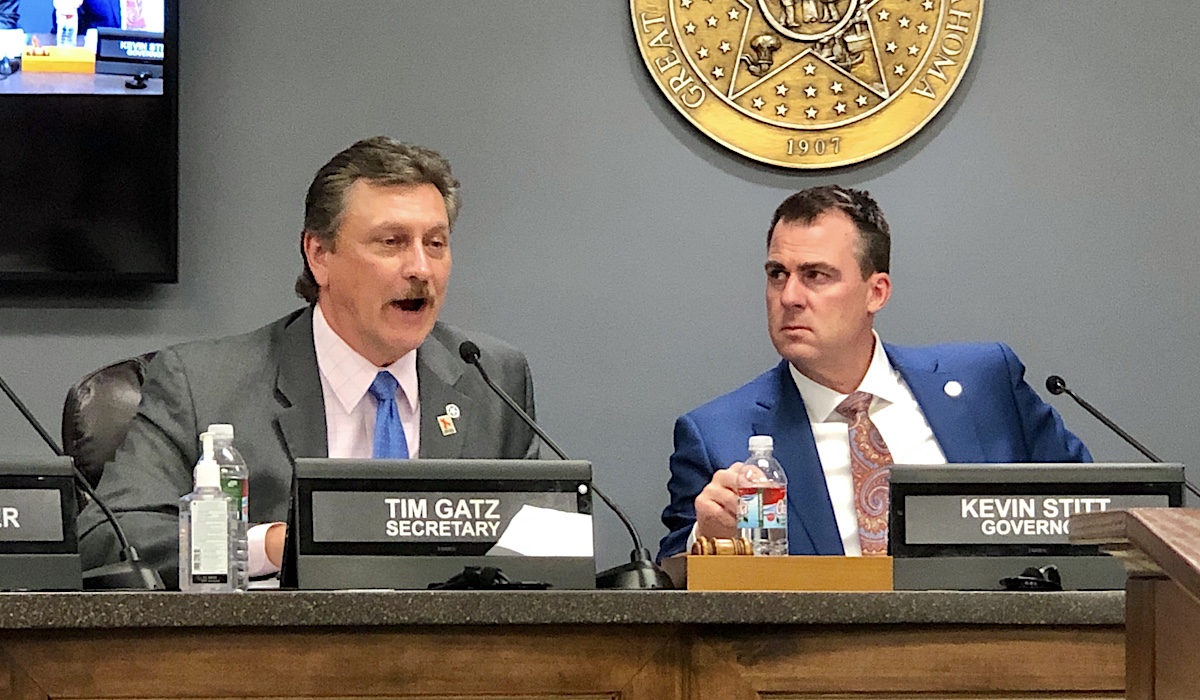
At the conclusion of Tuesday’s Board of Equalization, Stitt traveled two blocks from the Capitol to attend a meeting of the Oklahoma Turnpike Authority Board. The board approved initiation of a $5 billion, 15-year turnpike planning effort that will expand the Will Rogers Turnpike and much of the John Kilpatrick Turnpike to six lanes, among other network improvements. Agency leaders emphasized that cashless tolling implementation is allowing greater investment in expanding the turnpikes.
“I think investing in infrastructure is going to make a generational impact and help Oklahoma’s economy grow for the future,” Stitt said. “All of this is possible, I think, because of some of the fiscal discipline our Legislature has had in recent history.”
Included in the Advancing and Connecting Communities and Economies Safely Statewide (ACCESS) will include new turnpike legs, one looping northeast from Purcell around Norman and another connecting east-west between Norman and Moore. The Turnpike Authority has a new website for the ACCESS effort, which includes an interactive map.
Stitt said the planning effort shows a “bold vision” that will help cut travel time in half for people coming from I-35 south of Norman and heading to the Tulsa area.
“Our commutes are 15 minutes compared to 55 minutes in the Dallas-Fort Worth markets,” Stitt said. “It’s something we always hammer when we are recruiting business here.”
Secretary of Transportation Tim Gatz, who serves as director of the Turnpike Authority and the Department of Transportation, said the ACCESS effort has been planned in conjunction with ODOT’s existing eight-year construction work plan.
“Those two infrastructure investment packages on the tax-supported system and on the turnpike system will position Oklahoma to be the transportation hub of the future,” Gatz said. “That is how big this program is. It will be generational in its impact.”
Gatz said negotiating with property owners to purchase right-of-way for new turnpike legs will be a priority for the agency, and Stitt noted that planning the projects more than a decade ahead of time is intended to limit the displacement of homes and businesses.










